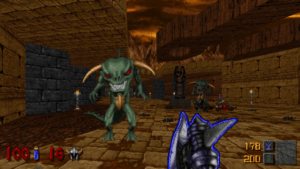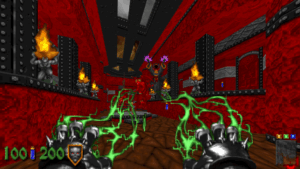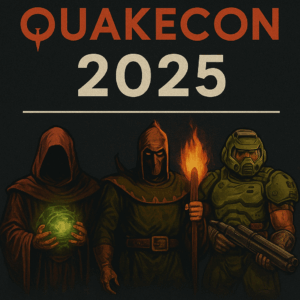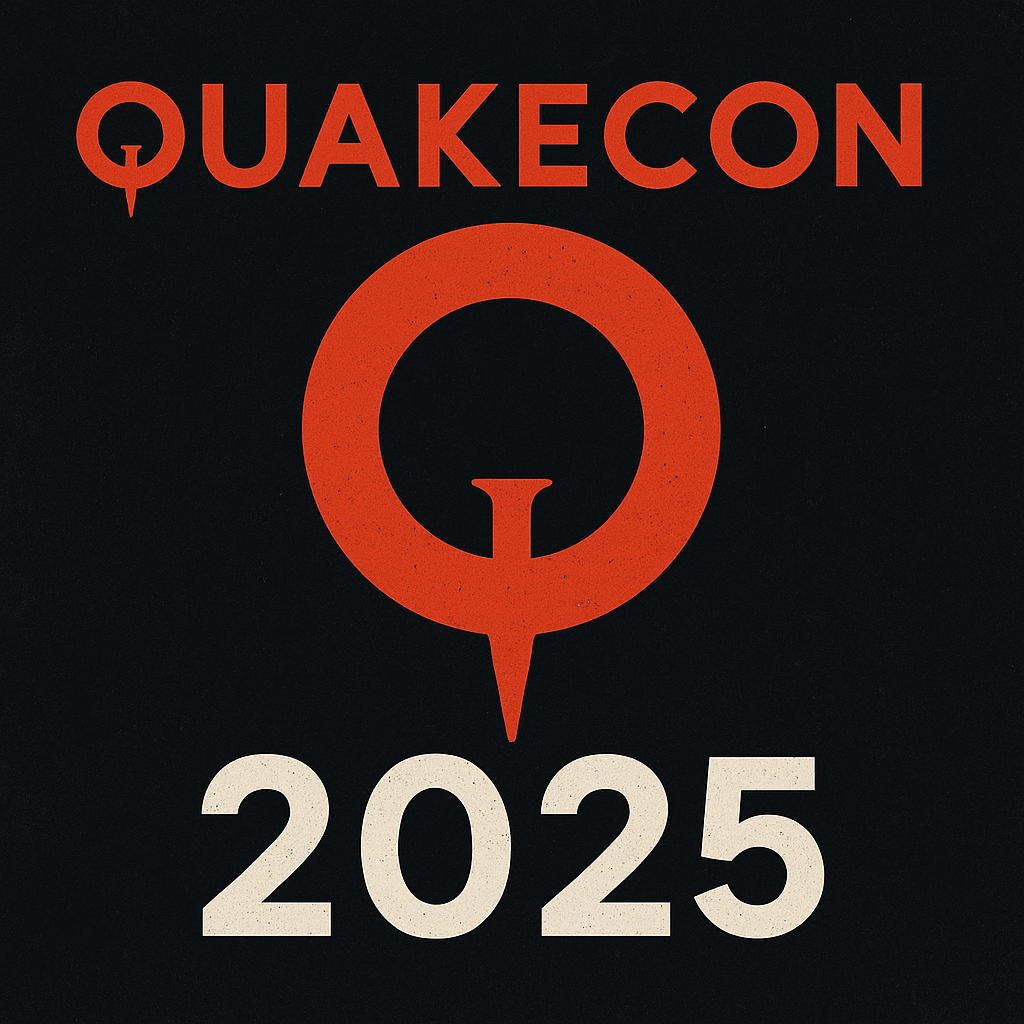The annual pilgrimage to Dallas concluded once again, and QuakeCon 2025 delivered exactly what the gaming community has come to expect from North America’s largest LAN party: surprises that honor the past while pushing toward an ambitious future. This year’s event felt particularly significant, not just for the announcements made, but for what they represent in gaming’s ongoing evolution, a perfect balance between preservation and innovation that speaks to both longtime fans and newcomers alike.
The Shadow Drop That Stunned the Industry
 The biggest surprise came during the welcome stream when id Software’s Marty Stratton and Hugo Martin announced that Heretic + Hexen, the definitive re-release of two genre-shaping first-person shooters, was available immediately. This wasn’t just another remaster announcement with a distant release date, it was a perfectly executed shadow drop that had fans downloading within minutes of the reveal.
The biggest surprise came during the welcome stream when id Software’s Marty Stratton and Hugo Martin announced that Heretic + Hexen, the definitive re-release of two genre-shaping first-person shooters, was available immediately. This wasn’t just another remaster announcement with a distant release date, it was a perfectly executed shadow drop that had fans downloading within minutes of the reveal.
The partnership between id Software and Nightdive Studios continues to prove its worth in the preservation space. Previously, this collaboration has resulted in acclaimed remasters for the original DOOM and its sequel, as well as Quake and Quake 2, but tackling Heretic and Hexen represents something deeper. These weren’t just id Software’s flagship titles, they were Raven Software’s fantasy-infused experiments that showed the DOOM engine could transcend its sci-fi origins.
Originally developed by Raven Software and produced by id Software, Heretic: Shadow of the Serpent Riders (1994) and its sequel, Hexen: Beyond Heretic (1995) changed FPS games forever by combining fast-paced shooter combat with fantasy elements. What made these games revolutionary wasn’t just their medieval aesthetic, but their willingness to experiment with RPG-like progression systems, puzzle-solving mechanics, and non-linear level design at a time when most shooters followed rigid formulas.
Modern Enhancements for Timeless Classics
The Heretic + Hexen collection doesn’t just slap a fresh coat of paint on aging code, it represents a comprehensive modernization effort. The remaster includes local and online cross-platform multiplayer, enhanced with all-new features, making these single-player-focused experiences suddenly relevant in today’s connected gaming landscape.
 The re-release includes all the DLC released for both titles, enhancements such as a remixed soundtrack by Andrew Hulshult, cross-platform and local multiplayer, and much more. Andrew Hulshult’s involvement is particularly noteworthy, his work on modern DOOM titles has shown he understands how to honor classic compositions while giving them contemporary power and clarity. This isn’t just nostalgia packaging; it’s artistic revival.
The re-release includes all the DLC released for both titles, enhancements such as a remixed soundtrack by Andrew Hulshult, cross-platform and local multiplayer, and much more. Andrew Hulshult’s involvement is particularly noteworthy, his work on modern DOOM titles has shown he understands how to honor classic compositions while giving them contemporary power and clarity. This isn’t just nostalgia packaging; it’s artistic revival.
Perhaps most impressively, owners of the original games on PC receive this combined re-release absolutely for free. In an era where remasters often feel like cash grabs, this gesture demonstrates genuine respect for the community that kept these titles alive through decades of digital distribution changes and compatibility challenges.
The technical scope is impressive: the definitive re-release of Heretic + Hexen is available on PC, Xbox One, Xbox Series X|S, PlayStation 4, PlayStation 5, and Nintendo Switch. This multi-platform approach ensures these games can find new audiences across every major gaming ecosystem, from handheld sessions on Switch to high-performance experiences on current-generation consoles.
DOOM: The Dark Ages Evolves
 While the Heretic + Hexen announcement stole headlines, QuakeCon 2025 also brought substantial updates to id Software’s current flagship. A significant gameplay update to DOOM: The Dark Ages was announced, including Update 2 which revealed a huge balance pass for the campaign and customizable Horde mode.
While the Heretic + Hexen announcement stole headlines, QuakeCon 2025 also brought substantial updates to id Software’s current flagship. A significant gameplay update to DOOM: The Dark Ages was announced, including Update 2 which revealed a huge balance pass for the campaign and customizable Horde mode.
Update 2 introduces the customizable Ripatorium, id Software’s take on Horde mode, suggesting the developer recognizes that modern audiences want more ways to engage with their meticulously crafted combat systems. The balance pass for the campaign indicates ongoing commitment to fine-tuning the experience based on community feedback, a practice that has become essential in today’s live-service gaming environment.
Additionally, a limited-time free QuakeCon 2025 DOOM Slayer skin is available from August 7 through September 1 for players who link their Bethesda.net accounts. While cosmetic rewards might seem minor, they represent the kind of community engagement that keeps players invested in franchises beyond their initial purchase.
Community-Driven Innovation
One of the most exciting developments announced was DOOM Eternal PC mods being made available for all players, with a new launcher allowing PC players to browse, download and play community-published mods, plus combine multiple mods. This represents a fundamental shift in id Software’s approach to community content, moving from passive tolerance to active facilitation.
The ability to combine multiple mods transforms DOOM Eternal from a finished product into a platform for continuous experimentation. This democratization of content creation could extend the game’s lifespan indefinitely while fostering a creative community that keeps pushing the boundaries of what’s possible within the DOOM framework.
The Hardware Partnership Evolution
NVIDIA’s presence at QuakeCon 2025 included custom DOOM: The Dark Ages PC giveaways, a $10,000 mod contest, and RTX demonstrations, highlighting how hardware partnerships have evolved beyond simple sponsorships into collaborative showcases of technological capability. These partnerships serve multiple purposes: they demonstrate the visual potential of current-generation hardware while providing tangible incentives for community engagement and content creation.
The intersection of hardware advancement and game preservation creates interesting possibilities. As GPUs become more powerful, classic games can be enhanced in ways their original developers never imagined, while new titles can push visual boundaries that seemed impossible just years ago.
Looking Forward: What the Future Holds
There’s speculation about potential announcements for remasters like Heretic 2 and Hexen 2, as gamers have made their interests loud and clear on forums. The success of the Heretic + Hexen collection could easily pave the way for tackling Raven Software’s later entries in these franchises, which experimented with full 3D environments and more complex storytelling.
While Heretic II and Hexen II are available on digital storefronts, they might receive remasters at a future QuakeCon. Given Nightdive Studios’ track record and the positive reception of their latest work, it seems more like a question of “when” rather than “if.”
The broader implications extend beyond individual game announcements. QuakeCon 2025 demonstrated that the gaming industry can successfully balance commercial viability with cultural preservation. By treating classic games as living documents worthy of continued investment rather than museum pieces, companies like id Software and Nightdive Studios are ensuring that gaming’s foundational experiences remain accessible and relevant.
The Bigger Picture
 QuakeCon 2025 wasn’t just about individual game announcements, it was about demonstrating a philosophy that respects gaming’s history while embracing its future. The event showed how preservation efforts can coexist with cutting-edge development, how community engagement can drive official support for user-generated content, and how shadow drops can still generate genuine excitement in an industry often plagued by leaks and predictability.
QuakeCon 2025 wasn’t just about individual game announcements, it was about demonstrating a philosophy that respects gaming’s history while embracing its future. The event showed how preservation efforts can coexist with cutting-edge development, how community engagement can drive official support for user-generated content, and how shadow drops can still generate genuine excitement in an industry often plagued by leaks and predictability.
The success of events like QuakeCon 2025 suggests that gaming’s future lies not in abandoning its past, but in finding innovative ways to make that past relevant to new audiences. Whether through technical enhancements, cross-platform availability, or community-driven content creation, the path forward seems to honor where gaming came from while pushing toward where it’s going.
For gamers, this represents the best possible outcome: a industry that values its legacy while continuously pushing boundaries. QuakeCon 2025 proved that nostalgia and innovation don’t have to be opposing forces, they can be complementary elements in gaming’s ongoing evolution.
The convention may be over, but its impact will resonate throughout the gaming year, setting expectations for how classic games should be treated and modern ones should evolve. In a world where gaming culture moves at breakneck speed, QuakeCon 2025 reminded us that sometimes the most exciting announcements are the ones that honor where we’ve been while showing us where we’re going.

